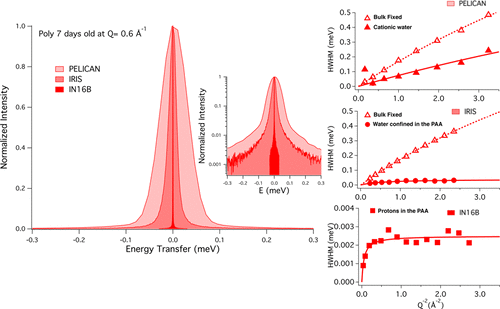当前位置:
X-MOL 学术
›
ACS Appl. Mater. Interfaces
›
论文详情
Our official English website, www.x-mol.net, welcomes your feedback! (Note: you will need to create a separate account there.)
Nanoscale Mobility of Aqueous Polyacrylic Acid in Dental Restorative Cements
ACS Applied Materials & Interfaces ( IF 9.5 ) Pub Date : 2018-03-05 00:00:00 , DOI: 10.1021/acsami.7b15735 Marcella C. Berg 1, 2 , Ana R. Benetti 3 , Mark T. F. Telling 4, 5 , Tilo Seydel 6 , Dehong Yu 7 , Luke L. Daemen 8 , Heloisa N. Bordallo 1, 2
ACS Applied Materials & Interfaces ( IF 9.5 ) Pub Date : 2018-03-05 00:00:00 , DOI: 10.1021/acsami.7b15735 Marcella C. Berg 1, 2 , Ana R. Benetti 3 , Mark T. F. Telling 4, 5 , Tilo Seydel 6 , Dehong Yu 7 , Luke L. Daemen 8 , Heloisa N. Bordallo 1, 2
Affiliation

|
Hydrogen dynamics in a time range from hundreds of femtoseconds to nanoseconds can be directly analyzed using neutron spectroscopy, where information on the inelastic and quasi-elastic scattering, hereafter INS and QENS, can be obtained. In this study, we applied these techniques to understand how the nanoscale mobility of the aqueous solution of polyacrylic acid (PAA) used in conventional glass ionomer cements (GICs) changes under confinement. Combining the spectroscopic analysis with calorimetric results, we were able to separate distinct motions within both the liquid and the GICs. The QENS analysis revealed that the self-diffusion translational motion identified in the liquid is also visible in the GIC. However, as a result of the formation of the cement matrix and its setting, both translational diffusion and residence time differed from the PAA solution. When comparing the local diffusion obtained for the selected GIC, the only noticeable difference was observed for the slow dynamics associated with the polymer chain. Additionally, over short-term aging, progressive water binding to the polymer chain occurred in one of the investigated GICs. Finally, a considerable change in the density of the GIC without progressive water binding indicates an increased polymer cross-linking. Taken together, our results suggest that accurate and deep understanding of polymer–water binding, polymer cross-linking, as well as material density changes occurring during the maturation process of GIC are necessary for the development of advanced dental restorative materials.
中文翻译:

牙科修复用水泥中聚丙烯酸水溶液的纳米级迁移率
可以使用中子光谱法直接分析数百飞秒至纳秒范围内的氢动力学,从中可以获得有关非弹性和准弹性散射的信息,此后称为INS和QENS。在这项研究中,我们应用这些技术来了解常规玻璃离聚物水泥(GIC)中使用的聚丙烯酸(PAA)水溶液的纳米级迁移率如何在受限条件下发生变化。将光谱分析与量热结果相结合,我们能够分离液体和GIC内的不同运动。QENS分析显示,在液体中识别出的自扩散平移运动在GIC中也可见。但是,由于水泥基质的形成及其凝固,平移扩散和停留时间均不同于PAA解决方案。当比较为所选GIC获得的局部扩散时,观察到与聚合物链相关的缓慢动力学的唯一显着差异。此外,经过短期老化,在一种被研究的GIC中,水逐渐与聚合物链结合。最后,GIC密度的显着变化而没有逐步的水结合表明聚合物交联的增加。综上所述,我们的结果表明,对GIC的成熟过程中发生的聚合物与水的结合,聚合物交联以及材料密度变化的准确而深入的了解对于开发先进的牙齿修复材料是必要的。当比较为所选GIC获得的局部扩散时,观察到与聚合物链相关的缓慢动力学的唯一显着差异。此外,经过短期老化,在一种被研究的GIC中,水逐渐与聚合物链结合。最后,GIC密度的显着变化而没有逐步的水结合表明聚合物交联的增加。综上所述,我们的结果表明,对GIC的成熟过程中发生的聚合物与水的结合,聚合物交联以及材料密度变化的准确而深入的了解对于开发先进的牙齿修复材料是必要的。当比较所选GIC的局部扩散时,观察到与聚合物链相关的慢动力学仅有的明显差异。此外,经过短期老化,在一种被研究的GIC中,水逐渐与聚合物链结合。最后,GIC密度的显着变化而没有逐步的水结合表明聚合物交联的增加。综上所述,我们的结果表明,对GIC的成熟过程中发生的聚合物与水的结合,聚合物交联以及材料密度变化的准确而深入的了解对于开发先进的牙齿修复材料是必要的。在研究的GIC之一中发生了水与聚合物链的渐进结合。最后,GIC密度的显着变化而没有逐步的水结合表明聚合物交联的增加。综上所述,我们的结果表明,对GIC的成熟过程中发生的聚合物与水的结合,聚合物交联以及材料密度变化的准确而深入的了解对于开发先进的牙齿修复材料是必要的。在研究的GIC之一中发生了水与聚合物链的渐进结合。最后,GIC密度的显着变化而没有逐步的水结合表明聚合物交联的增加。综上所述,我们的结果表明,对GIC的成熟过程中发生的聚合物与水的结合,聚合物交联以及材料密度变化的准确而深入的了解对于开发先进的牙齿修复材料是必要的。
更新日期:2018-03-05
中文翻译:

牙科修复用水泥中聚丙烯酸水溶液的纳米级迁移率
可以使用中子光谱法直接分析数百飞秒至纳秒范围内的氢动力学,从中可以获得有关非弹性和准弹性散射的信息,此后称为INS和QENS。在这项研究中,我们应用这些技术来了解常规玻璃离聚物水泥(GIC)中使用的聚丙烯酸(PAA)水溶液的纳米级迁移率如何在受限条件下发生变化。将光谱分析与量热结果相结合,我们能够分离液体和GIC内的不同运动。QENS分析显示,在液体中识别出的自扩散平移运动在GIC中也可见。但是,由于水泥基质的形成及其凝固,平移扩散和停留时间均不同于PAA解决方案。当比较为所选GIC获得的局部扩散时,观察到与聚合物链相关的缓慢动力学的唯一显着差异。此外,经过短期老化,在一种被研究的GIC中,水逐渐与聚合物链结合。最后,GIC密度的显着变化而没有逐步的水结合表明聚合物交联的增加。综上所述,我们的结果表明,对GIC的成熟过程中发生的聚合物与水的结合,聚合物交联以及材料密度变化的准确而深入的了解对于开发先进的牙齿修复材料是必要的。当比较为所选GIC获得的局部扩散时,观察到与聚合物链相关的缓慢动力学的唯一显着差异。此外,经过短期老化,在一种被研究的GIC中,水逐渐与聚合物链结合。最后,GIC密度的显着变化而没有逐步的水结合表明聚合物交联的增加。综上所述,我们的结果表明,对GIC的成熟过程中发生的聚合物与水的结合,聚合物交联以及材料密度变化的准确而深入的了解对于开发先进的牙齿修复材料是必要的。当比较所选GIC的局部扩散时,观察到与聚合物链相关的慢动力学仅有的明显差异。此外,经过短期老化,在一种被研究的GIC中,水逐渐与聚合物链结合。最后,GIC密度的显着变化而没有逐步的水结合表明聚合物交联的增加。综上所述,我们的结果表明,对GIC的成熟过程中发生的聚合物与水的结合,聚合物交联以及材料密度变化的准确而深入的了解对于开发先进的牙齿修复材料是必要的。在研究的GIC之一中发生了水与聚合物链的渐进结合。最后,GIC密度的显着变化而没有逐步的水结合表明聚合物交联的增加。综上所述,我们的结果表明,对GIC的成熟过程中发生的聚合物与水的结合,聚合物交联以及材料密度变化的准确而深入的了解对于开发先进的牙齿修复材料是必要的。在研究的GIC之一中发生了水与聚合物链的渐进结合。最后,GIC密度的显着变化而没有逐步的水结合表明聚合物交联的增加。综上所述,我们的结果表明,对GIC的成熟过程中发生的聚合物与水的结合,聚合物交联以及材料密度变化的准确而深入的了解对于开发先进的牙齿修复材料是必要的。


























 京公网安备 11010802027423号
京公网安备 11010802027423号